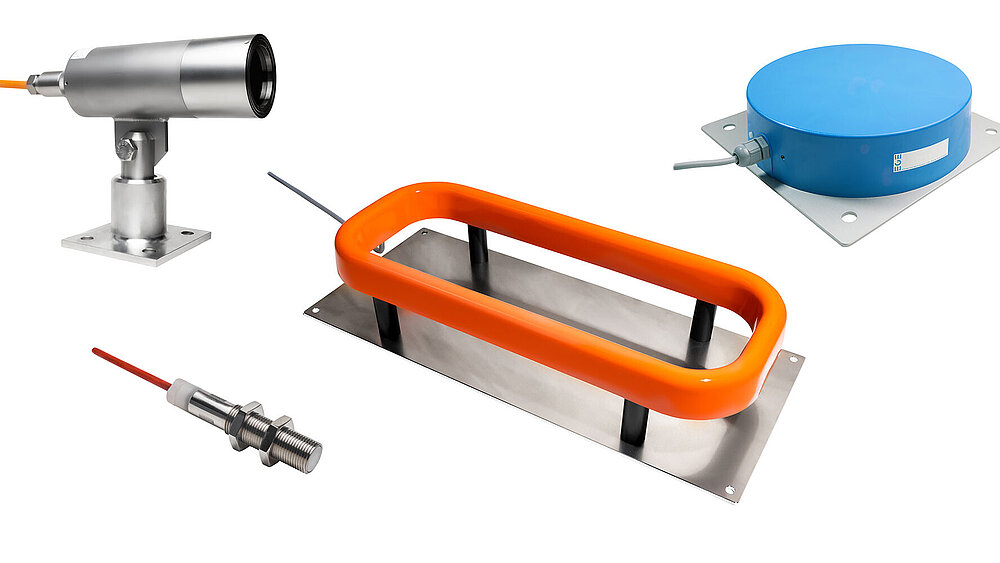
Sensors for object detection include proximity switches and detectors. They perform a variety of tasks - from reliable presence control and position monitoring to distance measurement of objects.
An inductive proximity switch works with a high frequency oscillating circuit that creates an alternating electromagnetic field on the active sensor surface by means of a coil. When a metallic object nears this field a damping occurs in the oscillating circuit. If this damping exceeds a threshold value, a switching signal is generated.
A capacitive proximity switch works with a high frequency oscillating circuit that creates an electromagnetic field on the active sensor surface by means of a capacitor. When a substantial or fluid substance nears this field a capacitance unbalance occurs and leads to a variation of the amplification in the oscillating circuit. If this amplification exceeds a threshold value, a switching signal is generated.
Ultrasonic sensors from EGE are used for non-contact object detection, distance detection and level measurement up to 6 meters measuring distance. EGE offers ultrasonic sensors for applications in humid environments in protection class IP 68/69 K as well as ultrasonic sensors in small compact designs.
Ultrasonic sensors continuously emit an ultrasonic pulse. The signal is reflected from the surface of the object. The distance to the object is determined from the transit time of the echo.
In addition to distance measurement and level detection, the sensors also serve as proximity switches for presence control, position and motion monitoring, as well as counting objects and speed control on conveyor belts.
Infrared detectors from EGE are used to detect hot objects and to detect and measure temperature. The sensors detect the infrared rays of warm and hot objects from 20 °C to 2000 °C. Infrared detectors from EGE are designed for use in extreme conditions.
With their glass and stainless steel housing, they are waterproof to IP 68 / IP 69. With attachment optics, they can be used at ambient temperatures of up to 500 °C.
An optional air purge makes the sensors insensitive to contamination of the optics. The detectors are used, among other things, to detect steel slabs or hot wire rod or for non-contact temperature control of malting barley in germination tanks.
Talk to our experts for flow and flow sensor technology about your request. Feel free to contact us directly by phone via e-mail or contact form.
Contact usEGE System 3000 metal detectors reliably detect metal parts in the conveyed material on conveyor belts. The System 3000 consists of an evaluation unit and a compact detector coil.
EGE metal detectors detect harmful large metal parts while being insensitive to smaller harmless metallic contaminants in the conveyed material.
The system automatically ignores static metal parts of the surrounding structure.
The devices are resistant to climatic changes, waterproof and designed for outdoor use - for example, on mobile installations.
EGE metal detectors reliably protect stone crushers, waste presses, mills and other processing plants that could be damaged by larger metal parts.
The operating distance is the distance between an object and the active sensor surface at which a switching signal is generated. The operating distance depends on the diameter of the coil. Therefore larger sensors are required for longer operating distances. On some of the EGE sensors the operating distance is adjustable.
If a metal object dampens only a part of the alternating field, the operating distance decreases; a larger object increases it. The following approximate values are derived from a standard rectangular measurement plate made of steel ST 37 with an edge length that corresponds to the diameter of the sensor coil or three times the rated operating distance, whichever is greater.
The operating distance is influenced by the material of the object: Constant dimensions for different materials against steel ST 37 yield a changed operating distance.
The following table lists approximate values for the material dependent reduction factors. In practical applications variations could occur due to different alloying, for example.
When collocating the sensors, a minimum separation must be kept between the devices. When in doubt, a test should be conducted under application conditions.
For flush mounting the lateral separation between two sensors must correspond to at least the diameter of the sensor.
For non flush mounting, the lateral separation from each other must correspond to at least twice the diameter of the sensor.
For oppositely mounted sensors, a minimal separation of six times the rated operating distance should be allowed.
Serial connection
For the serial connection of two wire or three wire sensors the individual voltage drops are added together. Therefore there is a lesser operational voltage at the disposal of the load. The addition of the switch-on delay times should be noted.
Parallel connection
The parallel connection of two wire sensors can only be conditionally recommended since the residual currents are added together and flow through the load. For the parallel connection of three wire sensors, the current consumption of the individual devices is added together. Since this current does not flow through the load, the maximum number of parallel connectable three wire sensors depends only on the power supply.